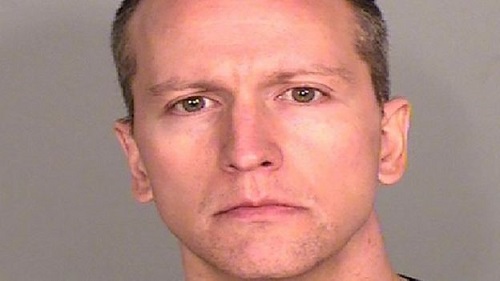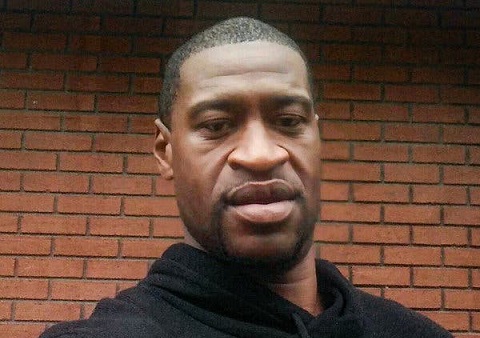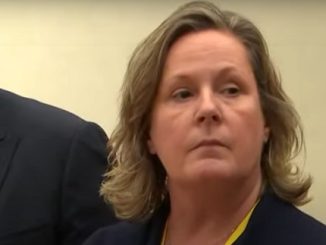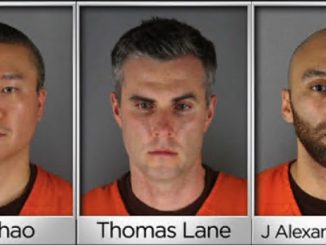
A former Minneapolis police officer has been arrested and charged with murder following the death of an unarmed black man in custody.
Derek Chauvin, who is white, was shown in footage kneeling on 46-year-old George Floyd’s neck on Monday. He and three other officers have been sacked.
Days of looting and arson in the Minnesota city have boiled over into nationwide protests.
The case has reignited US anger over police killings of black Americans.
What did the prosecutor say?
Hennepin County Prosecutor Mike Freeman said Mr Chauvin was charged with third-degree murder and second-degree manslaughter.
He said he “anticipates charges” for the three other officers but would not offer more details.
Mr Freeman said his office “charged this case as quickly as evidence has been presented to us”.
“This is by far the fastest that we’ve ever charged a police officer,” he noted.
According to the criminal complaint, Mr Chauvin acted with “a depraved mind, without regard for human life”.
What’s the latest on the protests?
On Friday evening, the White House was placed on lockdown after a protest was held outside. “I can’t breathe,” demonstrators could be heard chanting, invoking the last words of Mr Floyd and Eric Garner, a black man who died after being held in a police chokehold in New York in 2014.
The lockdown ended at about 20:30 EDT (00:30 GMT Saturday), with the US Secret Service reopening the building’s entrances and exits to staff.
Meanwhile, curfews have been ordered for the Twin Cities of Minneapolis-Saint Paul, from 20:00 to 06:00 on both Friday and Saturday night.
On Thursday, during the third night of protests over Mr Floyd’s death, a police station was set alight. A number of buildings have been burned, looted and vandalised in recent days, prompting the activation of the state’s National Guard troops.
In Atlanta on Friday, a police vehicle was set alight as protesters gathered near the offices of news broadcaster CNN.
There have also been demonstrations elsewhere, including New York, Los Angeles, Chicago, Denver, Houston, Louisville, Phoenix, Columbus and Memphis.
Frustration was already simmering over the recent deaths of two other black Americans, Ahmaud Arbery in Georgia and Breonna Taylor.

How did George Floyd die?
The full report by the county medical examiner has not been released, but the complaint states that the post-mortem examination did not find evidence of “traumatic asphyxia or strangulation”.
The medical examiner noted Mr Floyd had underlying heart conditions and the combination of these, “potential intoxicants in his system” and being restrained by the officers “likely contributed to his death”.

Nearly two minutes before he removed his knee the other officers checked Mr Floyd’s right wrist for a pulse and were unable to find one. He was taken to the Hennepin County Medical Center in an ambulance and pronounced dead around an hour later.
The Minnesota police handbook states that officers trained on how to compress a detainee’s neck without applying direct pressure to the airway can use a knee under its use-of-force policy. This is regarded as a non-deadly-force option.
What has Trump said?
At the White House on Friday, President Donald Trump called the incident “a terrible, terrible thing” and said he had spoken with Mr Floyd’s family, whom he described as “terrific people”.
He said he had asked the justice department to expedite an investigation it announced on Friday into whether any civil rights laws were violated in Mr Floyd’s death.
The president also said “looters should not be allowed to drown out the voices of so many peaceful protesters”.
Earlier, he described the rioters as “thugs” who were dishonouring Mr Floyd’s memory.
Social media network Twitter accused Mr Trump of glorifying violence in a post that said: “When the looting starts, the shooting starts.”
What’s the reaction?
Mr Floyd’s family and their lawyer, Benjamin Crump, said that the arrest was “welcome but overdue”.
The family said they wanted a more serious, first-degree murder charge as well as the arrest of the other officers involved.
The statement called for the city to change its policing, saying: “Today, George Floyd’s family is having to explain to his children why their father was executed by police on video.”
Former US President Barack Obama also weighed in, saying: “This shouldn’t be ‘normal’ in 2020 America.”
His statement added: “If we want our children to grow up in a nation that lives up to its highest ideals, we can and must be better.”
Minnesota Governor Tim Walz said the arrest was “a good first step toward justice”.
What happened in the arrest?
Officers suspected Mr Floyd had used a counterfeit $20 (£16) note and were attempting to put him in a police vehicle when he dropped to the ground, telling them he was claustrophobic.
According to police, he physically resisted officers and was handcuffed.
Video of the incident does not show how the confrontation started, but a white officer can be seen with his knee on Mr Floyd’s neck, pinning him down.
Mr Floyd can be heard saying “please, I can’t breathe” and “don’t kill me”.
A former local nightclub owner has said Mr Chauvin and Mr Floyd both worked as bouncers at her venue in south Minneapolis up until last year, though it is unclear if they knew one another.
Viewpoint: Frightening words
By Barrett Holmes Pitner
In saying “when the looting starts, the shooting starts”, President Donald Trump echoed a December 1967 quote from Miami Police Chief Walter Headley.
It was used as a threat towards African Americans in Miami and as part of his brutal “get tough policy” where he advocated the use of guns and dogs to stop civil rights protests.
In August of 1968, as Richard Nixon addressed the Republican National Convention in Miami, the police there killed three protesters, injured 18, and arrested over 200 people. Similar violent police attacks defined America during the 1960s, as African Americans fought for civil rights and voting rights. It is not a widely known phrase, but Headley’s sentiments have long been part of the American status quo – US law enforcement and political figures have made many statements invoking Headley and they still do today. It’s frightening to now hear Headley’s words emanate from the highest reaches of our government.
Barrett is a writer and journalist based in Washington, DC
Source: bbc.co.uk






Be the first to comment